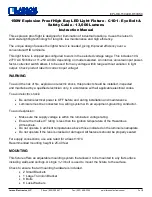
36
Cleaning and Storage
1. Disengage the power take off (PTO), set the parking
brake, and turn the ignition key to off. Remove the
key.
2. Remove grass clippings, dirt, and grime from the
external parts of the entire machine, especially the
engine. Clean dirt and chaff from the outside of the
engine’s cylinder head fins and blower housing.
Important
You can wash the machine with mild
detergent and water. Do not pressure wash the machine.
Avoid excessive use of water, especially near the control
panel, and engine.
3. Check the brake; refer to Servicing the Brake, page 25.
4. Service the air cleaner; refer to Servicing the Air
Cleaner, page 21.
5. Grease the machine; refer to Greasing and Lubrication,
page 24.
6. Change the crankcase oil and filter; refer to Servicing
the Engine Oil, page 22.
7. Change the hydraulic system oil and filter; refer to
Changing the Hydraulic Oil and Filter, page 30.
8. Remove the battery from the chassis, check the
electrolyte level, and charge fully; refer to Servicing
the Battery, page 33. Do not connect the battery cables
to the battery posts during storage.
Important
The battery must be fully charged to
prevent it from freezing and being damaged at
temperatures below 0
°
C (32
°
F). A fully charged battery
maintains its charge for about 50 days at temperatures
lower than 4
°
C (40
°
F). If temperatures will be above
4
°
C (40
°
F), check the electrolyte level in the battery and
charge every 30 days.
9. Check the tire pressure; refer to Checking the Tire
Pressure, page 26.
10. During long-term storage, either drain gasoline from
the fuel tank (step 11) or add a fuel
stabilizer/conditioner additive to a full tank of gasoline
(step A).
11. Drain gasoline from the fuel tank. After fuel is
drained, start the engine and let it idle until all
gasoline is consumed and the engine stops. This
eliminates gum-like buildup in the fuel system, which
causes hard starting. Try to start the engine two more
times to assure that no gasoline is in the fuel system.
A. Add the correct amount of a fuel
stabilizer/conditioner to a full tank of gasoline.
Note: Stabilizer/conditioners normally preserve gasoline
for six to eight months.
12. Remove the spark plug(s) and check its condition;
refer to Servicing the Spark Plug, page 23. With the
spark plug(s) removed from the engine, pour two
tablespoons of engine oil into the spark plug hole.
Now use the starter to crank the engine and distribute
the oil inside the cylinder. Install the spark plug(s). Do
not install the wire on the spark plug(s).
13. Check and tighten all bolts, nuts, and screws. Repair or
replace any part that is damaged or defective.
14. Paint all scratched or bare metal surfaces. Paint is
available from your Authorized Service Dealer.
15. Store the machine in a clean, dry garage or storage
area. Remove the key from the ignition switch and
keep it in a memorable place. Cover the machine to
protect it and keep it clean.
Troubleshooting
PROBLEM
POSSIBLE CAUSES
CORRECTIVE ACTION
Starter does not rotate.
1. Power take off (PTO) switch is
engaged.
1. Move (PTO) switch to
disengaged.
2. Traction control pedal is not in
neutral.
2. Move traction control pedal to
neutral position.
3. Electrical connections are
corroded or loose.
3. Check electrical connections
for good contact.
4. Fuse is blown.
5. Battery is dead.
4. Replace fuse.
5. Charge battery.
6. Solenoid or switch is defective.
6. Contact Authorized Service
Dealer.





































